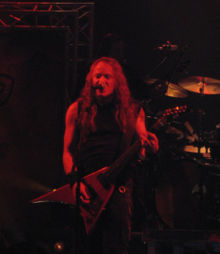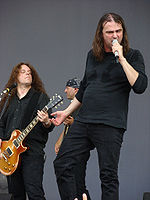- Power metal
-
This article is about the sub-genre of heavy metal music. For the Pantera album, see Power Metal (album). For the Metallica demo, see List of Metallica demos#Power Metal demo.
Power metal Stylistic origins NWOBHM, speed metal, thrash metal Cultural origins Early–mid 1980s, Germany Typical instruments Vocals − electric guitar − bass − drums − keyboards Mainstream popularity Medium in Europe, Japan, South America and North America, and underground in Asia. Fusion genres Symphonic metal Regional scenes Germany - Scandinavia - Finland - Italy - Brazil - Japan Power metal is a style of heavy metal combining characteristics of traditional metal with speed metal, often within symphonic context. The term refers to two different but related styles: the first pioneered and largely practiced in North America with a harder sound similar to speed metal, and a later more widespread and popular style based in Europe (especially Germany, Finland, Italy, Scandinavia), Argentina, Brazil, and Japan with a lighter, more melodic sound and frequent use of keyboards.
Contents
Musical characteristics
 Kai Hansen of Gamma Ray during a show in Barcelona, Spain. Hansen is widely regarded as the "grandfather of power metal."
Kai Hansen of Gamma Ray during a show in Barcelona, Spain. Hansen is widely regarded as the "grandfather of power metal."
Power metal is today associated with fast tempo and melodic harmonies, the sound tempered by characteristics of speed metal, power metal's musical forerunner.
Vocals
Power metal is highly focused on the vocalist, with "clean" vocals being much more prevalent than the growling vocals often associated with extreme metal. Following in the tradition of Ronnie James Dio, Ian Gillan, Eric Adams, Bruce Dickinson, Rob Halford and other heavy metal vocalists, power metal vocals are often in a high register. The majority of the genre's vocalists sing in the tenor range, capable of hitting very high notes. There are however many exceptions who sing in either baritone or bass range, or even make use of growls. Many power metal vocalists record multi-layered vocals reminiscent of Queen, creating a choral effect.[1]
Lyrical themes
Power metal's lyrical themes, though as varied as metal itself, often focus on fantasy and mythology, camaraderie and hope, personal struggles and emotions, war and death, or combinations of the listed themes. Many Power metal bands based their concept albums on fantasy books and national epics, as well as on their own imaginary stories. Many otherwise typical metal themes such as religion and politics are comparatively rare but not unheard of.
Instrumentation
Power metal guitarists and bassists generally play rapid streams of notes, but change chords comparatively slowly, with a harmonic tempo of once per measure or slower. Fast and demanding guitar solos, however, are almost guaranteed. The slow changing of chords are significant in defining power metal just as the fast rapid chord changes often define traditional thrash metal. Power metal often makes use of Major chord progressions as well as circle progressions. Some of the most influential and imitated power metal guitarists are Kai Hansen of Gamma Ray, Michael Weikath of Helloween, and Timo Tolkki formerly of Stratovarius, currently of Symfonia. It is a common trait in power metal for the bass guitar to take a back seat, so to speak; often simply providing the chord root notes and being drowned out by the more prevalent rhythm guitars. However, some power metal bands incorporate bass that is more audible with colorful patterns distinct from the rhythm guitars, such as Helloween, Hibria, and Symphony X.
Many power metal drummers play with double bass pedals or two bass drums, utilizing them to play a constant stream of sixteenth notes (semiquavers) with snare drum accents on the beat, a style not restricted to, but most often associated with, power metal. The style was used by drummer Ingo Schwichtenberg of Helloween, setting a blueprint for many other drummers to follow. Others, such as the drummers of Blind Guardian and Iced Earth, use a more thrash metal style of drumming with rapid bursts of double bass that involve three to six beats with the double kick. Even more uncommon, but not unheard of, is the use of the blast beat.
Power metal bands often incorporate keyboards into their musical arrangements, something popularized by Jens Johansson of Stratovarius, though their usage varies from subtle accents to a full-blown melody line. Some power metal bands also record with symphonic elements, and as such, they utilize a full orchestra to fill the role usually played by the keyboardist.
Types of power metal
American power metal
This branch of power metal emerged in early 1980s in the United States, drawing its influences mainly from speed metal and the NWOBHM. Though very close to its roots, US power metal (often abbreviated USPM) is often faster than standard heavy metal, with a more riff-driven approach than its later European counterpart, but more melodic and often with a higher emphasis on guitar leads than thrash. Another notable difference is the relative lack of keyboards in American power metal, in contrast to their almost universal presence in the European variety. USPM is also notable for its wide (but not universal) use of high-register operatic vocals, a trend which would continue with the rise of European power metal in the late 80s and early 90s. Many major US power metal bands, such as Fates Warning, were also pivotal in pioneering the progressive metal genre. US power metal saw a sharp decline in popularity at the beginning of the 90s, though the style has rebounded somewhat in the past decade.
European power metal
Often referred to as melodic power metal, European power metal originated from the New Wave of British Heavy Metal, emerging in mid/late 1980s with Germany's Helloween, Blind Guardian and Finland's Stratovarius, with a strong focus on melody and uplifting, positive themes. Helloween mixed fast palm muted speed metal riffs with high-pitched clean vocals. Stratovarius further developed this melodic direction by making heavy use of keyboards. This genre spread over Europe, often incorporating further influences from classical and folk music. The style has become one of the most popular metal subgenres, and has many bands outside of Europe.
See also
Literature
- Sharpe-Young, Garry (2003). A-Z of Power Metal. Rockdetector Series. Cherry Red Books. pp. 464. ISBN 9781901447132.
- Dio, Ronnie James; Bukszpan, Daniel (2003). The Encyclopedia of Heavy Metal. Barnes & Noble Publishing. pp. 300. ISBN 0760742189.
- Kahn-Harris, Keith (2007). Extreme metal: music and culture on the edge. Rockdetector Series. Berg Publishers. pp. 194. ISBN 1845203992.
References
- ^ Helloween cover Queen's song 'Sheer Heart Attack' (Blabbermouth net)
External links
Heavy metal Subgenres Alternative metal · Avant-garde metal · Black metal · Christian metal · Crust punk · Death metal · Djent · Doom metal · Drone metal · Extreme metal · Folk metal · Funk metal · Glam metal · Gothic metal · Grindcore · Groove metal · Industrial metal · Metalcore · Neo-classical metal · Nintendocore · Nu metal · Post-metal · Power metal · Progressive metal · Rap metal · Sludge metal · Speed metal · Stoner metal · Symphonic metal · Thrash metal · Traditional heavy metal · Viking metalNotable scenes Culture Heavy metal subculture · Fashion · Subgenres · Bands · Festivals · Umlaut · Headbanging · Sign of the hornsCategories:
Wikimedia Foundation. 2010.

